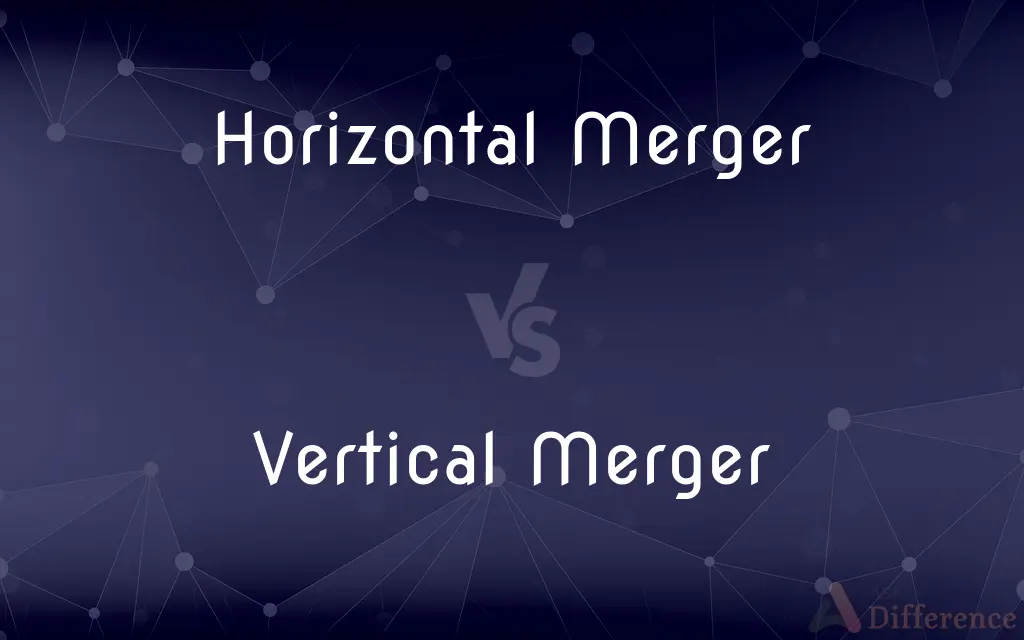Horizontal Merger vs. Vertical Merger — What's the Difference?
By Tayyaba Rehman — Published on October 11, 2023
Horizontal Merger involves companies at the same stage in the same industry combining, aiming to expand market share. Vertical Merger is when companies at different stages in the same supply chain combine, aiming to reduce costs and increase efficiency.

Difference Between Horizontal Merger and Vertical Merger
Table of Contents
ADVERTISEMENT
Key Differences
A Horizontal Merger occurs between firms operating in the same industry, typically as competitors, to achieve economies of scale, increase market share, or reduce competition. In contrast, a Vertical Merger is when companies at different stages of the production process combine, often to secure supply chains or distribution channels, allowing for enhanced efficiency and cost control. Both mergers aim to attain synergies but operate in different realms of business strategy and integration.
Horizontal Mergers often involve companies of similar sizes and structures, merging to leverage combined resources and capabilities to increase competitive advantage. These mergers may result in an expanded product range or enhanced market presence. Vertical Mergers, however, involve companies at different production or supply stages, intending to create a more seamless, integrated, and efficient value chain, reducing dependencies on external suppliers or distributors.
The strategic motivations behind Horizontal Mergers primarily revolve around expansion and consolidation in the same industry, often pursued to achieve cost efficiencies, eliminate redundancies, and increase market power. On the other hand, Vertical Mergers are driven by the desire to control more stages of the supply chain, ensuring smoother operations, more reliable inputs, and sometimes, more effective market access.
In Horizontal Mergers, anti-trust concerns are prominent due to the possibility of reduced competition, potentially leading to monopolistic market structures. Regulatory bodies meticulously scrutinize such mergers to prevent market dominance and protect consumer interests. Vertical Mergers, while also subject to regulatory review, usually pose less risk to competition since the combining firms do not directly compete, focusing more on creating synergistic benefits through integration.
Comparison Chart
Industry Relation
Occurs between firms in the same industry.
Involves firms at different stages of production.
ADVERTISEMENT
Strategic Goal
To achieve economies of scale and increase market share.
To secure supply chains or distribution channels.
Competition Concerns
Raises significant anti-trust concerns.
Poses less risk to competition.
Integration Type
Consolidation in the same industry.
Integration along the supply chain.
Primary Benefit
Enhanced market presence and product range.
Improved operational efficiency and cost control.
Compare with Definitions
Horizontal Merger
Horizontal Merger is usually between firms of similar sizes and structures.
The Horizontal Merger of the equally matched corporations was considered a merger of equals.
Vertical Merger
Vertical Merger occurs between companies at different stages of the production or supply chain.
The Vertical Merger between the manufacturer and the supplier aimed to streamline operations.
Horizontal Merger
Horizontal Merger can lead to expanded product range and market presence.
The Horizontal Merger resulted in a more diverse product portfolio for the company.
Vertical Merger
Vertical Merger typically poses less risk to competition compared to horizontal mergers.
Regulatory approval for the Vertical Merger was smoother due to lesser competition concerns.
Horizontal Merger
Horizontal Merger seeks to achieve economies of scale and enhanced market power.
The firms anticipated significant economies of scale from the Horizontal Merger.
Vertical Merger
Vertical Merger allows for greater control over different stages of production and distribution.
The Vertical Merger provided the company more control over its product distribution.
Horizontal Merger
Horizontal Merger often raises anti-trust concerns due to potential reduced competition.
Regulators scrutinized the Horizontal Merger closely for any anti-competitive effects.
Vertical Merger
Vertical Merger aims to achieve synergies through integration along the value chain.
The resultant synergies from the Vertical Merger improved the firms’ overall efficiency.
Horizontal Merger
Horizontal Merger is a consolidation between competing companies in the same industry.
The Horizontal Merger between the two airlines aimed to boost market share.
Vertical Merger
Vertical Merger is intended to secure supply chains or enhance access to distribution channels.
The companies pursued a Vertical Merger to secure a reliable supply of raw materials.
Common Curiosities
What is a Horizontal Merger?
It is a merger between companies operating in the same industry, usually as competitors, aiming to increase market share and achieve economies of scale.
How do Horizontal Mergers benefit the merging companies?
They can lead to enhanced market presence, product diversification, cost efficiencies, and increased market power.
Why are Horizontal Mergers often scrutinized by regulatory bodies?
They can lead to reduced competition and potentially create monopolistic market structures, which can be detrimental to consumer interests.
What is the main goal of a Vertical Merger?
The primary goal is to integrate companies at different stages of the production process, usually to secure supply chains or distribution channels and improve operational efficiency.
Can Vertical Mergers reduce operational costs?
Yes, they often aim to reduce costs by securing supply chains, optimizing resource allocation, and improving overall operational efficiency.
Can Vertical Mergers integrate companies from different industries?
Yes, as long as the companies are at different stages of the production or distribution process of a specific product or service.
Can a Horizontal Merger result in a larger product portfolio?
Yes, combining product ranges of merging companies often leads to a more diversified and extensive product portfolio.
Why would a company opt for a Vertical Merger?
To gain more control over the supply chain or distribution channels, mitigate risks related to supply disruptions, and to achieve synergies through integrated operations.
Are Horizontal Mergers between direct competitors common?
Yes, they often involve direct competitors aiming to consolidate market positions, reduce competition, and achieve economies of scale.
Do Vertical Mergers involve companies of different sizes?
Often, yes. They usually involve companies operating at different stages of the production or distribution process, which can vary in size.
Share Your Discovery

Previous Comparison
Sliding Friction vs. Rolling Friction
Next Comparison
Dissolution of Partnership vs. Dissolution of FirmAuthor Spotlight
Written by
Tayyaba RehmanTayyaba Rehman is a distinguished writer, currently serving as a primary contributor to askdifference.com. As a researcher in semantics and etymology, Tayyaba's passion for the complexity of languages and their distinctions has found a perfect home on the platform. Tayyaba delves into the intricacies of language, distinguishing between commonly confused words and phrases, thereby providing clarity for readers worldwide.













































